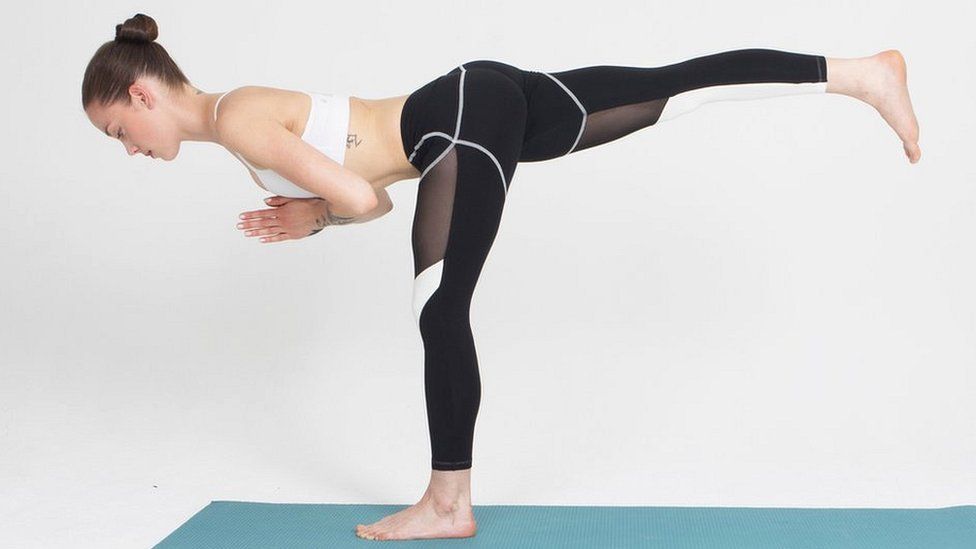From yoga pants to smart shoes: The technology of touch
- Published

Imagine being able to navigate the streets just by receiving vibrations in your footwear. Or feeling a tingle in your yoga tights if your Downward Dog position needs improvement.
And what if you could feel the things you're touching as you roam through a virtual reality (VR) world?
This is the science of haptics, the intersection between technology and the sense of touch.
For most of us, our experience of haptics has been restricted to a buzz in our pockets when a phone message arrives, or "force feedback" on gaming joysticks and steering wheels.
But observers believe the technology, which has been in development for decades, is finally ready to hit the big time thanks to faster processors, cheaper sensors and the take-up of VR headsets.
Smart shoes
The global market for haptics tech is forecast to reach nearly $20bn (£16bn) by 2022, according to research firm Research and Markets.
So what are some of the real-world applications of this "touchy-feely" tech?
Well, if you've bumped into lamp posts and fellow tourists trying to follow map directions on your phone, smart shoes and insoles could be the answer.
Embedded with haptic sensors that are connected via Bluetooth to your phone's navigation app, the shoes vibrate, telling you whether to turn left, right or carry straight on.
"Through touch a lot of information is being processed by the brain, but the brain isn't trying to compute what it means," says Krispian Lawrence, chief executive of makers Ducere Technologies.
"It's just an instinctive reaction."
While the footwear was originally intended to help visually impaired people, Ducere is also appealing to athletes or anyone who wants route guidance without having to stare at their phones all the time.
Tricky position
And vibrations can be applied to other parts of the body, too (no tittering at the back).
Australian company Wearable Experiments is using haptics to help yoga devotees know when they need to correct their shape. The firm's Nadi X yoga tights have several sensors embedded in them at the hips, knees and ankles.
"We use pose detection software that determines what is correct and incorrect," says Wearable Experiments designer and director Billie Whitehouse.
"This is communicated back to the person wearing the pants with directional feedback, indicating which way to rotate the hip, knee or ankle to do the correct alignment."
By increasing the frequency and intensity of the vibrations the tights tell you how far off you are from the ideal positions as illustrated in an accompanying app.
The firm hopes to apply the technology to a range of interactive clothing, and has already launched a vibrating shirt for fans that enables spectators to feel, as well as see, the action.
And people with back problems could be alerted when their posture needs improving, for example.
Feel, don't touch
Of course, we can feel things without necessarily touching them and it is the art of simulating the sense of touch that is proving so important in the VR world.
"Haptic sensations are generated by skin displacement and forces on the human body, and a particular combination of skin displacement and applied force is associated with each sensation," says Eric Vezzoli, founder of GoTouchVR.com, a haptic technology company.
This requires another machine to generate the sensation.
Some companies are experimenting with targeted ultrasound as a way of simulating the feeling of pressing buttons or turning dials even though your hand is waving about in thin air.
Controlling devices without touching them
And this ultrasound technique is also being applied to tablet screens, varying their slipperiness at different points to mimic the feeling of pressing 3D buttons. This feeling can also be achieved using highly-targeted vibrations or electrical impulses.
The motor industry in particular is interested in these techniques so that drivers can operate flat screen displays without taking their eyes off the road.
Combine these ultrasound techniques with high-definition cameras and VR glasses and it should be possible to transmit a sense of touch across the world, enabling people to shake hands or hug despite being thousands of miles apart.
Telerobotics
A more direct approach is to don exoskeletal gloves that manipulate the hand to mimic the sensation of touching or holding objects in a virtual setting.
UK-based company Generic Robots has developed SimuTouch, a training platform for surgeons and dentists that employs haptics-enabled machines and VR to simulate real-world procedures.
While viewing haptically enabled virtual images of teeth, a dental student holds a realistic dental tool, like a drill, that is connected to a haptic machine. As the student moves the drill around, the haptic device pushes back and recreates the forces that would be experienced if real-life drilling were taking place.
"Force-feedback haptic devices are small robots mounted on the desk or worn on the hand like an exoskeleton that recreate the experience of shape, stiffness and weight. They create realistic interactions in VR for training," explains Dr Alastair Barrow, director of Generic Robotics.
Although the company has been working on haptics for 10 years, it is the "cheap and easy access to the visual side of VR" that has proved to be a catalyst for the company, says Imogen Clare, the firm's head of communications.
Other companies working on similar technology include France-based HRV (Haptic Virtual Reality).
Market buzz
While the haptics market is forecast to grow strongly, the tech itself is still in its infancy, argues Mr Vezzoli.
"Our comprehension of the haptic system is nowhere comparable with our knowledge of the vision and hearing systems, where the in-depth knowledge of human perception and more than 100 years of technical development gave us Bluetooth noise-cancelling headphones and VR headsets," says Mr Vezzoli.
Ultimately, the success of haptics will depend upon designers and developers understanding how the sense of touch works scientifically, but also how it triggers us emotionally.
Technology will always need to have that human touch.